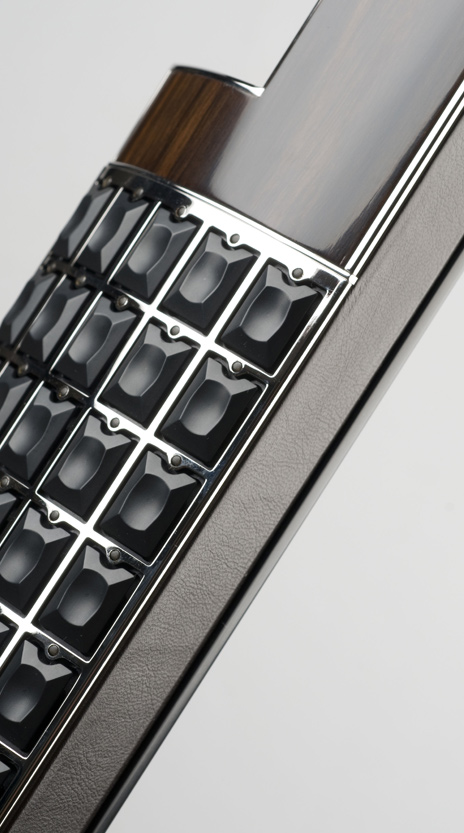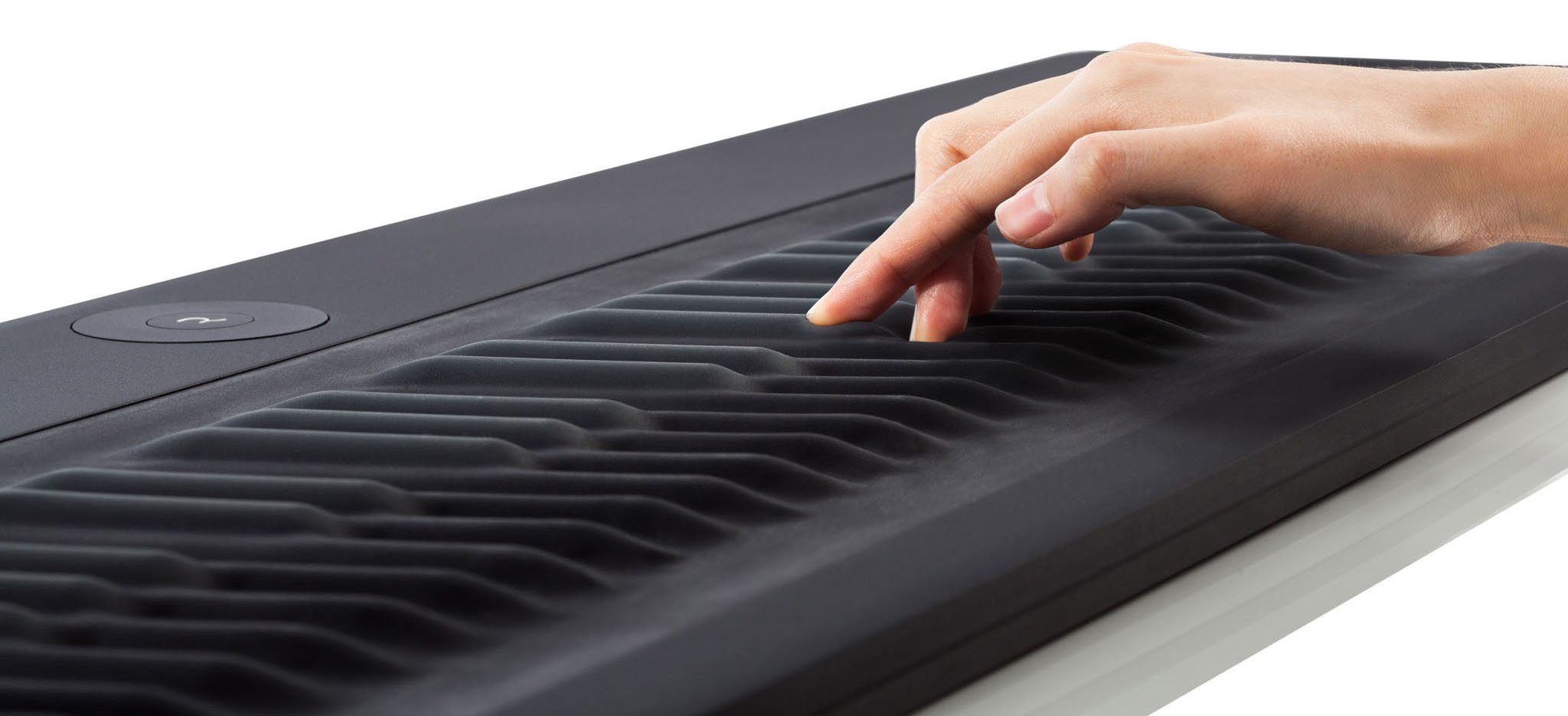Playing Animoog on the iPad is great, but what if your iPad was a meter wide and 20cm large? Wouldn’t that allow you to better play Animoog with such large touch keys instead of the rather small keys we get on our iPad? That’s what alternative controllers are about, and we have great news today for Animoog players.
A year ago we published an entry on Anicontrol and a custom MIDI controller, which are closer to regular controllers than the alternative ones. Alternative controllers is exactly the topic of this Jordan Rudess entry, keyboardist for Dream Theater, in the Keyboard Magazine.
But wait, does such controllers can be used with Animoog? Yes! Here’s the good news from Moog Developer Geert Bevin shared after the recent release of Animoog 2.2.4:
« An important improvement is that Animoog will now properly handle full-rate MIDI coming from the Eigenharp, LinnStrument, Continuum, … The massive amount of expression messages used to sometimes put Animoog into a weird state. We tracked this bug down and fixed it, making Animoog an excellent choice for any controller that supports polyphonic aftertouch! »
Excited? I am! I encourage you to read Jordan’s entry. Amongst the alternatives controllers Jordan reviews you’ll find:
The Haken Continuum:

The Eigenharp Alpha:

The ROLI Seaboard:

And the LinnStrument:

That last one looks the most unusual. The LinnStrument is also currently the less expensive of those alternative controllers, the ROLI Seaboard being the second less expensive. Over a year ago already, Geert posted the following short but insightful video testing Animoog with the LinnStrument.
Options for controlling Animoog have been one of my main interests as soon as I got Animoog in my hands. The proof is my first two entries on the official Moog forum, the first one posted less than three weeks after the launch of Animoog in 2011, were specifically asking about controllers. I was lucky to get answers from the community at the time that pointed to two alternative controllers, the Endeavour EVO and the VAX77 from Infinite Response, but those two controllers don’t seem to be available anymore. Today is a day to rejoice, we now have plenty of excellent alternative controllers available to us and Moog is really spending time to ensure those controllers are well supported by Animoog. Great times ahead!
Are you aware of other alternative controllers suitable for Animoog? If so, let us know in the comments below! Cheers — Alex / Satri

Following the publication of this entry, Greg reacted on Facebook to mention the upcoming Spaceharp (http://spaceharp.com). Since it’s not delivered to clients at the moment, customers can’t test it with Animoog yet.
That’s sure going to be a ‘different’ type of controller and I’m eager to see how efficiently and with how much precision it can be used with Animoog.
In another comment over Facebook, Duncan mentions the QuNexus (http://www.keithmcmillen.com/products/qunexus/). It’s not a touch input device, but mods Animoog’s polypressure with its aftertouch (key pressure). There’s a demo video on the QuNexus website where they show Animoog itself! The QuNexus a very affordable at $150
I got Animoog over a couple of years ago when it first came out, and found it to be exciting enough that I created a bank of over 64 completely original sounds for it, which do the instrument far greater justice than the factory presets. It was because of Animoog that I later got interested in the ROLI Seaboard, of which I received one of the first Seaboard GRAND Stage models shipped to the West Coast a year ago. Ironically, although all of my many hardware synths respond correctly to the Seaboard input, Animoog does not. This is because Animoog uses a different method for it’s polyphonic pitch bending. It does not respond on rotating MIDI channel input from the Seaboard GRAND, which is kind of a shame. It does respond to poly-pressure on a single channel, if the Seaboard is set up that way, but this response is not ideal either, as the Seaboard generally won’t send poly-pressure messages starting from zero. Any thoughts on this?
Hi Keyless, funny that you ask now. 3 weeks ago I got info from Moog about that, see http://forum.moogmusic.com/viewtopic.php?f=13&t=24964 for the links and response from Moog. I hope/think that Animoog will eventually fully support the Roli Seaboard. I have an appointment next week to test Animoog on the LinnStrument – I might post an entry about my experience. As for your presets, would you be ready to share them with other Animoog players? :-) Cheers — Alex / Satri
Thanks for your response. Since you have an interest in using the Seaboard with Animoog, here is some more info: First of all, I believe that there are differences in the way the Seaboard GRAND & the Seaboard RISE respond to touch. I haven’t tried the Rise, but I do have the NOISE iPad app and can say that it responds entirely differently than the GRAND, including the poly-pitch bending, which I much prefer on the GRAND. When I first got the Seaboard GRAND I was confused about the polyphonic pressure sensitivity, because it didn’t respond as I expected. I had a conversation with a ROLI rep about this, and he clarified ROLI’s approach on this, explaining that I should think of it more like “continuous touch” rather than “aftertouch”. As such, some patches on Animoog might respond acceptably from Seaboard input once you get used to what is actually going on, while other patches (especially those where poly-pressure affects pitch) are likely to be forever incompatible. I like the way Animoog implements this feature on the iPad surface and wouldn’t want that changed! So, I think that patches on the Animoog should be specifically designed or modified to be used with the Seaboard such that poly-pressure can be at least be useful, if not ideal. As for my presets, yes I would be interested in providing them as an expansion pack, but certainly not for free. A percentage of my patches (I’m not sure how many) utilize raw timbres from certain expansion packs available from the Moog store, so I’m not sure how that would work. I notice that you also have a Moog Theremini. I do too, and love it! I have created a handful of patches for that instrument as well. Those I wouldn’t mind giving away for free, since they are by necessity much simpler to create than Animoog patches.
Hi Keyless, thanks for the additional info, it’s valuable and appreciated! :-) Clearly, the current version of Animoog is not great with the Seaboard, but that will probably change with an eventual Animoog version.
For your presets, not a problem if they’re not free. Probably like other Animoog players, I’ll be happy to play with your presets! I’ll contact you directly about this.
For the Theremini presets, I’ll gladly add yours to https://www.animoog.org/theremini/
Cheers — Alex / Satri
While on the subject of keys and boards, does anyone know why the Animoog keyboard terminates at A#5? I like using the expressive keyboard to control other synths, but I’m limited to only so many octaves. The Animoog engine responds to MIDI notes higher than A#5, so why not its own keyboard? This has always puzzled me.